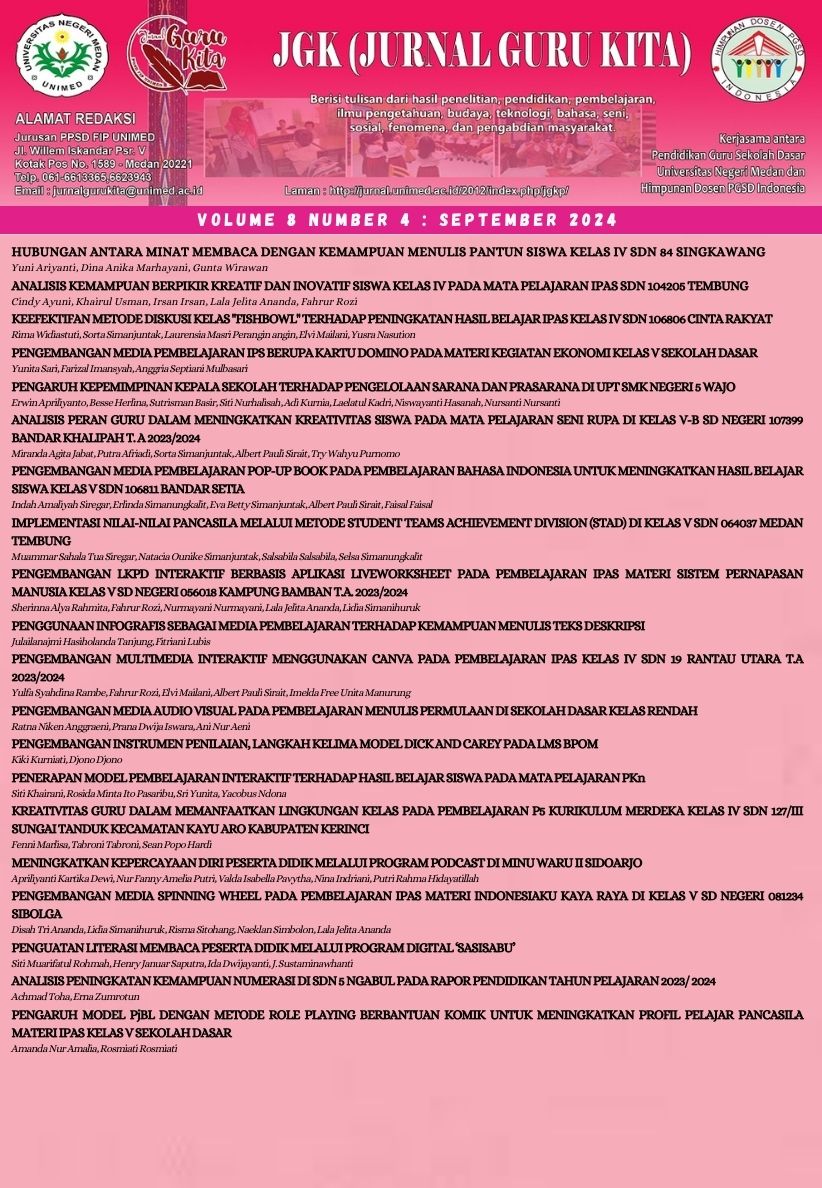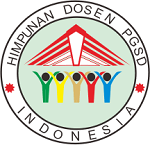PENGEMBANGAN INSTRUMEN PENILAIAN, LANGKAH KELIMA MODEL DICK AND CAREY PADA LMS BPOM
DOI:
https://doi.org/10.24114/jgk.v8i4.59383Keywords:
IDEAS, Pengembangan Kompetensi, Refleksi dalam Pembelajaran, Evaluasi Pembelajaran, Analisis DeskriptifAbstract
Pengembangan kompetensi melalui platform pembelajaran mandiri IDEAS di BPOM telah memfasilitasi pemenuhan kewajiban pengembangan kompetensi (20 JP), tetapi belum optimal dalam mencapai peningkatan kompetensi yang menyeluruh. Keterbatasan utama terletak pada penggunaan metode evaluasi pretest dan posttest, yang dirasa kurang mampu menggambarkan penerapan pengetahuan secara praktis. Penelitian ini bertujuan untuk mengeksplorasi efektivitas instrumen penilaian lain, yaitu refleksi dalam evaluasi pembelajaran untuk meningkatkan pemahaman dan aplikasi materi oleh pegawai. Metode penelitian ini menggunakan pendekatan deskriptif kuantitatif dan kualitatif untuk menganalisis data dari pretest, posttest, dan feedback formulir evaluasi. Temuan menunjukkan peningkatan signifikan dalam skor posttest dan preferensi peserta terhadap metode evaluasi yang lebih interaktif. Implikasi dari penelitian ini menegaskan bahwa penggunaan refleksi tidak hanya memperkaya proses evaluasi tetapi juga memfasilitasi pembelajaran yang lebih adaptif dan berkesinambungan.References
Akhmad, Riandy, & Agusta. (2022). Development of Learning Outcomes Assessment Instruments Using Computer Based Test (CBT). Edumaspul: Jurnal Pendidikan, 6(1), 255-267. https://doi.org/10.33487/edumaspul.v6i1.3070
Baharun, H. (2016). Penilaian Berbasis Kelas pada Pembelajaran Pendidikan Agama Islam di Madrasah. MODELING: Jurnal Program Studi PGMI, 3(2), 204“216.
Black, P., & Wiliam, D. (1998). Assessment and classroom learning. Assessment in Education: Principles, Policy & Practice, 5(1), 7-74. https://doi.org/10.1080/0969595980050102
Boud, D., Keogh, R., & Walker, D. (1985). Reflection: Turning experience into learning. Kogan Page.
Branch, R. M. (2009). Instructional design: The ADDIE approach. Springer.
Darling-Hammond, L. (2014). Next generation assessment: Moving beyond the bubble test to support 21st century learning. Jossey-Bass.
Dick, W., Carey, L., & Carey, J. O. (2009). The systematic design of instruction (7th ed.). Pearson.
Means, B., Toyama, Y., Murphy, R., Bakia, M., & Jones, K. (2010). Evaluation of evidence-based practices in online learning: A meta-analysis and review of online learning studies. U.S. Department of Education.
Noddings, N. (2013). Education and Democracy in the 21st Century. Teachers College Press.
Popham, W. J. (2009). Assessment literacy for teachers: Faddish or fundamental? Theory into Practice, 48(1), 4-11. https://doi.org/10.1080/00405840802577536
Schön, D. A. (1983). The reflective practitioner: How professionals think in action. Basic Books.
Schreiber, B., & Berge, Z. L. (2017). If you build it, will they come? A case study of digital spaces and the training of instructional designers. Journal of Asynchronous Learning Networks, 21(2), 15-33.
Taras, M. (2005). Assessment “ summative and formative “ some theoretical reflections. British Journal of Educational Studies, 53(4), 466-478. https://doi.org/10.1111/j.1467-8527.2005.00307.x
William, D. (2011). Embedded formative assessment. Solution Tree Press.
Zhao, Y., Pugh, K., Sheldon, S., & Byers, J. L. (2020). Conditions for classroom technology innovations. Teachers College Record.
Downloads
Published
How to Cite
Issue
Section
License
Copyright (c) 2024 Kiki Kurniati, Djono Djono

This work is licensed under a Creative Commons Attribution-ShareAlike 4.0 International License.
Authors published with the JGK (Jurnal Guru Kita) agree to the following terms:
- Authors retain copyright and grant the journal the right of first publication with the work simultaneously licensed under a Creative Commons Attribution License (CC BY-SA 4.0) that allows others to share the work with an acknowledgment of the work's authorship and initial publication in this journal.
- Authors are able to enter into separate, additional contractual arrangements for the non-exclusive distribution of the journal's published version of the work (e.g., post it to an institutional repository or publish it in a book), with an acknowledgment of its initial publication in this journal.
- Authors are permitted and encouraged to post their work online (e.g., in institutional repositories or on their website) prior to and during the submission process, as it can lead to productive exchanges, as well as earlier and greater citation of published work. (See The Effect of Open Access)




























